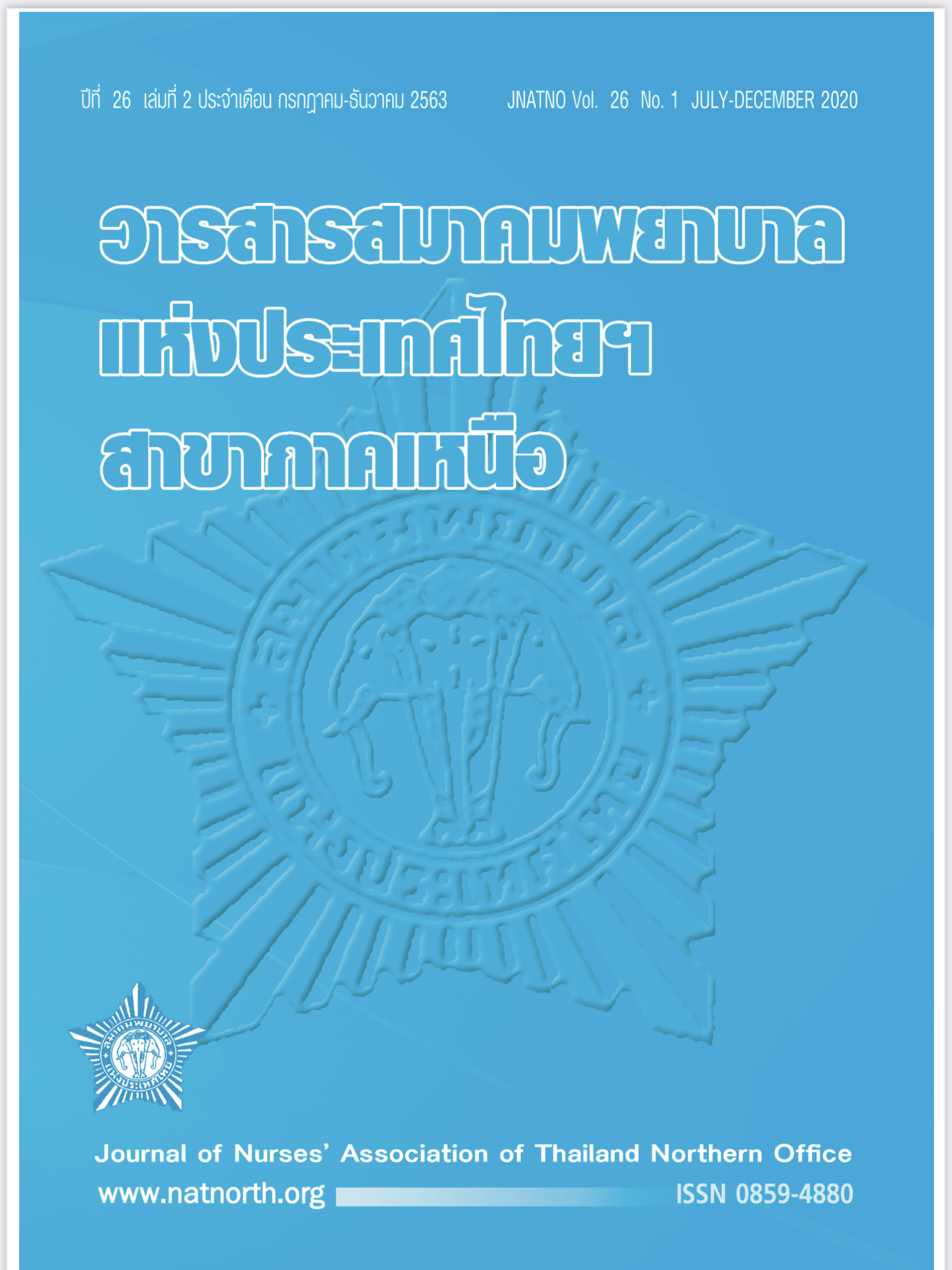Nurses’ roles in Supporting Self-management for Preventing Diabetic Foot Ulcer among Patients with Diabetes Mellitus
คำสำคัญ:
supporting self-management, Diabetic foot Ulcer, Patients with Diabetes Mellitus, Nurses' Rolesบทคัดย่อ
โรคเบาหวานเป็นโรคเรื้อรังที่จำเป็นต้องจัดการตนเอง เพื่อควบคุมอาการของโรคและภาวะแทรกซ้อนของโรคเบาหวาน โดยเฉพาะการเกิดแผลที่เท้าเบาหวานซึ่งเป็นสาเหตุหลักสำคัญที่นำไปสู่การตัดเท้าและส่งผลกระทบต่อคุณภาพชีวิตของผู้ป่วยเบาหวาน ดังนั้นการควบคุมภาวะเสี่ยงต่อการเกิดแผลที่เท้าเบาหวานและการกลับเป็นซ้ำของแผลที่เท้าเบาหวานจึงมีความสำคัญอย่างยิ่งสำหรับผู้ป่วยเบาหวานทุกคน ปัจจุบันมีหลักฐานเชิงประจักษ์ที่สนับสนุนว่าการจัดการตนเอง เป็นหัวใจสำคัญของการป้องกันการเกิดแผลที่เท้าเบาหวาน หากผู้ป่วยเบาหวานมีการดูแลเท้าที่ดีและมีความสามารถในการจัดการตนเองกับการดูแลเท้าที่เพิ่มขึ้น พยาบาลเป็นบุคลากรทางสุขภาพที่มีความใกล้ชิดกับผู้ป่วยเบาหวานมากที่สุด พยาบาลจึงมีบทบาทสำคัญในการสนับสนุนการจัดการตนเองของผู้ป่วยเบาหวาน ประกอบด้วย บทบาทของพยาบาลในการสนับสนุนงานที่ต้องจัดการตนเอง 3 ด้าน ได้แก่ 1) การจัดการทางการแพทย์และการรักษา 2) การจัดการการปรับพฤติกรรมหรือบทบาท และ 3) การจัดการด้านอารมณ์ บทบาทของพยาบาลในการฝึกทักษะในการจัดการตนเองให้กับผู้ป่วยเบาหวานเพื่อป้องกันการเกิดแผลที่เท้าเบาหวาน ประกอบ 6 ทักษะ ได้แก่ 1) ทักษะการแก้ไขปัญหา 2) ทักษะการตัดสินใจ 3) ทักษะการใช้แหล่งประโยชน์ 4) ทักษะการสร้างสัมพันธภาพระหว่างผู้ป่วยเบาหวานและพยาบาล 5) ทักษะการลงมือปฏิบัติ และ 6) ทักษะการปรับปรุงการดูแลเท้าเพื่อป้องกันการเกิดแผลที่เท้าเบาหวาน ซึ่งจะส่งผลในการป้องกันการเกิดแผลที่เท้าและทำให้มีสุขภาพเท้าที่ดีตลอดไป
เอกสารอ้างอิง
Ogurtsova K, Fernandes R, Huang Y, Linnenkamp U, Guariguata L, Cho NH, et al. IDF Diabetes Atlas: Global estimates for the prevalence of diabetes for 2015 and 2040. Diabetes Research and Clinical Practice 2017; 128:40–50.
สายฝน ม่วงคุ้ม. บทบาทพยาบาลในการดูแลเท้าเบาหวาน. Journal of The Royal Thai Army Nurses 2560; 18(ฉบับพิเศษ): 1-10.
ณัฐพงค์ โฆษชุณหนันท์. พยาธิสรีรวิทยาของโรคเท้าในผู้ป่วยเบาหวาน. ใน: ณัฐพงค์ โฆษชุณหนันท์ และคณะ, บรรณาธิการ. ตำราการป้องกันและรักษาโรคเท้าในผู้ป่วยเบาหวาน. กรุงเทพฯ: ทริค ธิงค์; 2556. หน้า. 21-34
Merriwether EN. Impact of foot progression angle modification on plantar loading in individuals with diabetes mellitus and peripheral neuropathy. Edorium J Disabil Rehabil 2016; 2(1): 15-23.
Formusa C, Gatt A, Chockalingam N. The importance of diabetes foot care education in a primary care setting. Journal of Diabetes Nursing 2012; 16(10): 410-14.
Moungkum S, Duangpaeng S, Baramee J. Factor influencing foot conditions among people with type 2 diabetes in east Thailand. Journal of Science, Technology, and Humanities 2011;9(2):65-74.
กรรณิการ์ ศรีสมทรง. ผลของการสนับสนุนการจัดการตนเองต่อพฤติกรรมการดูแลเท้าของผู้สูงอายุที่เป็นโรคเบาหวานชนิดที่ 2. วารสารสภาการพยาบาล 2560; 32(3): 120-134.
สถาบันวิจัยและประเมินเทคโนโลยีทางการแพทย์. แนวทางเวชปฏิบัติการป้องกันและดูแลรักษาผู้ป่วยเบาหวานที่มีภาวะแทรกซ้อนที่เท้า 2556. กรุงเทพฯ: โรงพิมพ์ชุมนุมสหกรณ์การเกษตรแห่งประเทศไทย; 2556.
LeoneS, Pascale R, Vitale M, Esposito S. Epidemiology of diabetic foot. Infez Med 2012; 20: 8-13.
สำนักงานหลักประกันสุขภาพแห่งชาติ.คู่มือบริหารกองทุนหลักประกันสุขภาพแห่งชาติ ปีงบประมาณ 2558 เล่มที่ 4 :การบริหารงบบริการควบคุมป้องกันและรักษาโรคเรื้อรัง 2557. กรุงเทพฯ:สหมิตรพริ้นติ้งแอนด์พับลิสซิ่ง.
อารีย์ เสนีย์. โปรแกรมการจัดการตนเองในผู้ป่วยโรคเรื้อรัง. วารสารพยาบาลทหารบก 2557; 15(2): 129-134.
ชุลีกร ด่านยุทธศิลป์. การส่งเสริมการจัดการตนเองในผู้ป่วยโรคปอดอุดกั้นเรื้อรัง. วารสารการพยาบาลและสุขภาพ 2560; 11(2) (ฉบับพิเศษ): 97-104
Creer TL. Self-management of chronic illness. In: Boekarts M, Pintrich P, Seidner M, editors. Self-regulation: theory, research, and applications. Orlando, FL: Academic Press; 2000. p. 601-29.
Bandura A. Self-efficacy: the exercise of control. New York: Freeman; 1997.
ศิริลักษณ์ ถุงทอง. บทบาทพยาบาลในการสนับสนุนการจัดการตนเองของผู้ป่วยล้างไตทางช่องท้องอย่างต่อเนื่อง. วารสารวิจัยและนวัตกรรมทางสุขภาพ 2561; 1(1): 46-57.
Creer TL. Self-management of chronic illness. In: Boekarts M, Pintrich P, Seidner M, editors. Self-regulation: theory, research, and applications. Orlando, FL: Academic Press; 2000. p. 601-29.
Lorig KR, Holman, HR. Self-management education: history, definition, outcomes, and mechanisms. Ann Behav Med 2003;26:1-7.
Ryan P, Sawin KJ. The individual and family self-management theory: background and perspectives on context, process, and outcomes. Nurs Outlook 2009;57(4):217-25.
ชดช้อย วัฒนะ.การสนับสนุนการจัดการตนเอง: กลยุทธ์ในการส่งเสริมการควบคุมโรค. วารสารวิทยาลัยพยาบาลพระปกเกล้า จันทบุรี 2558; 26: 117-127.
พัชรี อ่างบุญตา. ผลของโปรแกรมสนับสนุนการจัดการตนเองต่อพฤติกรรมการจัดการตนเองและระดับฮีโมโกลบินเอวันซีของผู้สูงอายุที่เป็นโรคเบาหวานชนิดที่ 2. พยาบาลสาร 2555; 39(3): 93-104.
Corbin JM, Strauss A. Unending work and care: Managing chronic illness at home. San Francisco: Jossey-Bass; 1988.
Lorig KR, Holman, HR. Self-management education: history, definition, outcomes, and mechanisms. Ann Behav Med 2003;26:1-7.
Sae-Sia W, Maneewat K, Kurniawan T. Effect of a self-management support program on diabetic foot care behaviors. International Journal of Research in Nursing 2013; 4(1):14-21.
ศรินญาภรณ์ พวงเงินมาก วันเพ็ญ แก้วปาน ปาหนัน พิชยภิญโญ และ อุไรวรรณ หาญวงค์. สมรรถนะของพยาบาลเวชปฏิบัติที่ปฏิบัติงานในคลินิกเบาหวาน ณ หน่วยบริการปฐมภูมิ จังหวัดเชียงใหม่. วารสารสมาคมพยาบาลแห่งประเทศไทยฯ สาขาภาคเหนือ 2560; 23(1): 11-20.
ประภัสสร ไชยชนะ และ จุฑามาศ กิติศรี. ผลของโปรแกรมการส่งเสริมสมรรถนะการดูแลตนเองโดยอาศัยรูปแบบเพื่อนช่วยเพื่อนต่อพฤติกรรมการดูแลตนเองและฮีโมโกลบินเอวันซีของผู้ป่วยเบาหวาน ชนิดที่ 2. วารสารสมาคมพยาบาลแห่งประเทศไทยฯ สาขาภาคเหนือ 2561; 24(1): 100-111.
ดาวน์โหลด
เผยแพร่แล้ว
รูปแบบการอ้างอิง
ฉบับ
ประเภทบทความ
สัญญาอนุญาต
บทความที่ได้รับการตีพิมพ์เป็นลิขสิทธิ์ของสมาคมพยาบาลแห่งประเทศไทยฯ สาขาภาคเหนือ
เนื้อหาและข้อคิดเห็นใดๆ ที่ตีพิมพ์ในวารสารสมาคมพยาบาลฯ ถือเป็นความรับผิดชอบของผู้เขียนเท่านั้น ผู้เขียนบทความต้องศึกษารายละเอียดหลักเกณฑ์การจัดทำต้นฉบับตามที่วารสารกำหนด และเนื้อหาส่วนภาษาอังกฤษต้องได้รับการตรวจสอบจากเจ้าของภาษามาแล้ว


